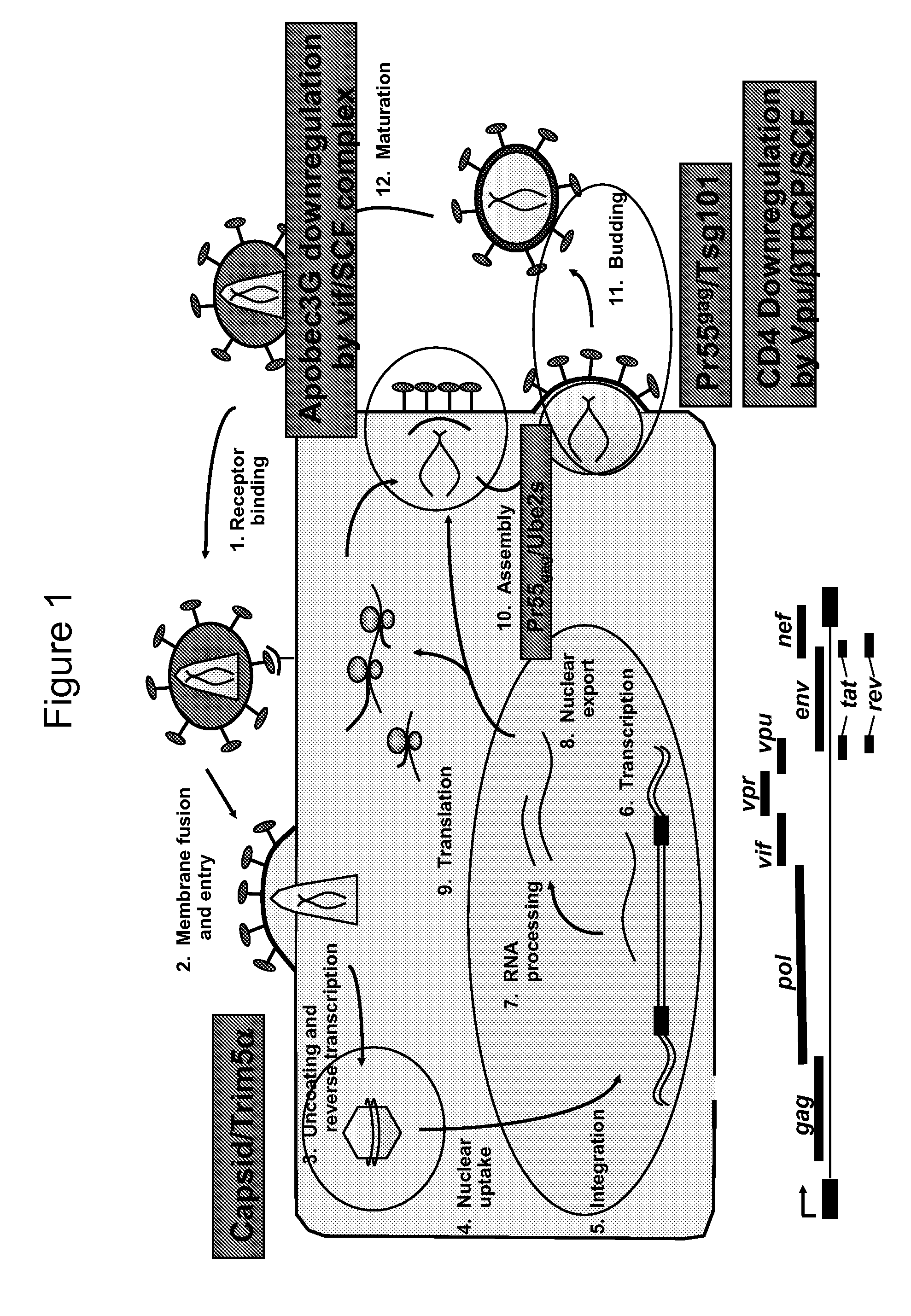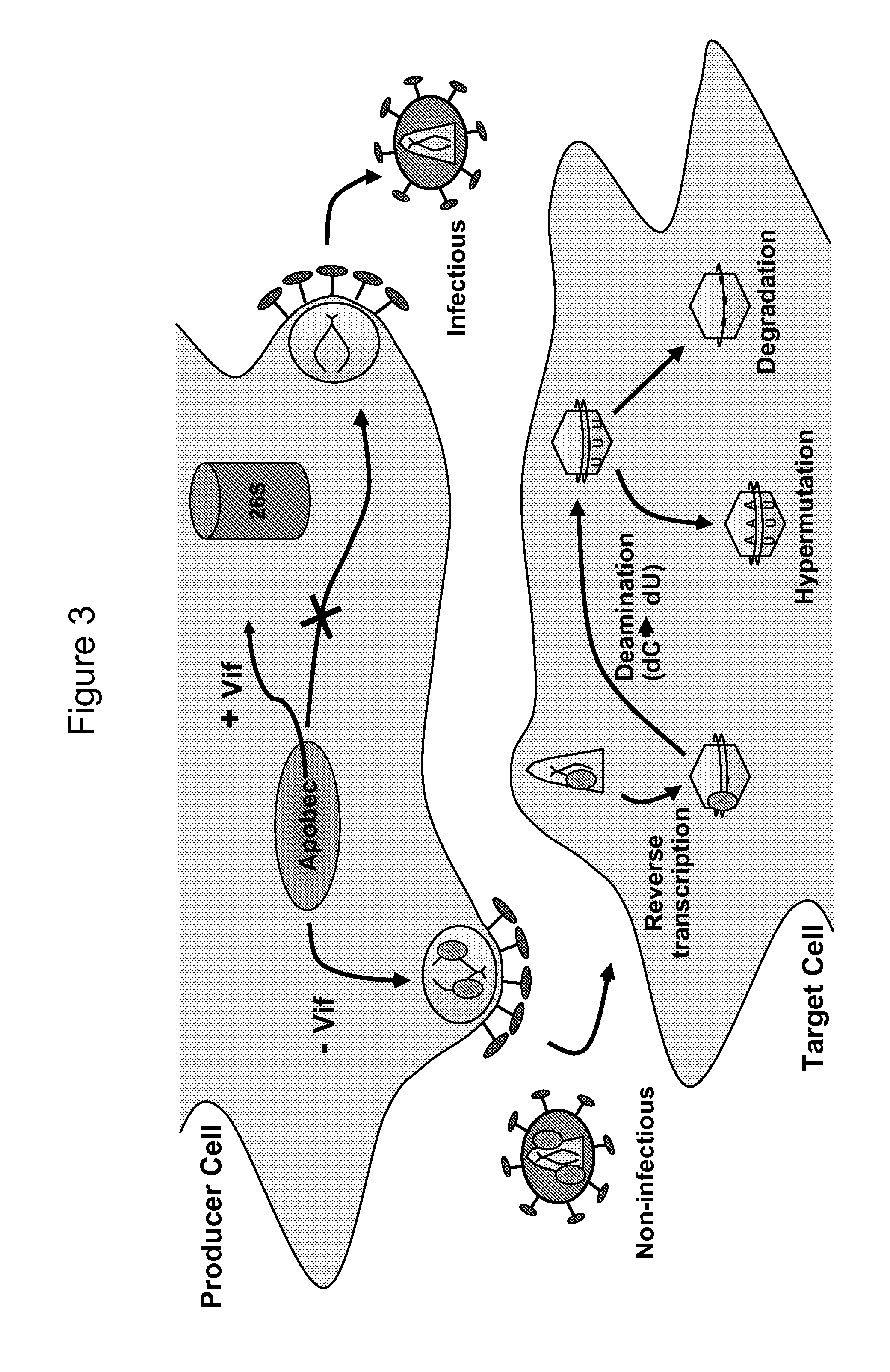Methods of Detecting Inhibitors of VIF-Mediated APOBEC3G Degradation and HIV
a technology of apobec3g degradation and detection method, which is applied in the field of hiv therapeutics, can solve the problems of reducing affecting the ubiquitination rate of apobec3g, and generating detrimental levels of retroviral genome mutations, so as to improve the ubiquitination rate and proteasome targeting of apobec3g, reduce the half-life of protein, and enhance the apobec3
- Summary
- Abstract
- Description
- Claims
- Application Information
AI Technical Summary
Benefits of technology
Problems solved by technology
Method used
Image
Examples
example 1
Cell-Based Screening Assay For Compounds That Inhibit Vif-Mediated APOBEC3G Degradation
[0129]Inhibitors of Vif-mediated APOBEC3G degradation were screened using a cell-based assay. A schematic of the assay is shown in FIG. 7A. The assay uses HeLa cells that stably expresses Vif and APOBEC3G fused at its C-terminus to firefly luciferase. Under steady-state conditions, there is very little luciferase activity. When degradation of the APOBEC3G-luciferase fusion is inhibited, a significant increase in the luciferase activity is observed. FIG. 7C shows the dose-response curve for the proteasome inhibitor MG132, which is known to increase APOBEC3G levels in the presence of Vif.
[0130]Construction of screening line (Vif / APOBEC3G-luciferase HeLa line). HeLa cells were cotransfected with a 1:1 ratio of pcDNA6-Vif and pcDNA3.1-APOBEC3G-luciferase plasmids using Fugene transfection reagent. Twenty-four hours after transfection, cells were trypsinized and different dilutions plated on 10 cm dish...
example 2
Response of Vif / APOBEC3G-Luc Line To Proteasome Inhibitors
[0131]The screening assay of Example 1 was used to measure that inhibitory activity of proteasome inhibitors, such as small molecules known to increase APOBEC3G levels in the presence of Vif. The response of the screening line to different proteasome inhibitors show that compounds can be detected that targeted the degradation pathway. Compounds tested include MG-132, Velcade, Epoxomicin and Lactacystin.
example 3
Diagram of HIV-Dependent Reporter Cell Line TZM-Bl
[0132]HIV infectivity was measured using the reporter cell line TZM-bl. TZM-bl is a HeLa line that contains two HIV-dependent reporter genes (Tranzyme). This line has been engineered to express the cell surface receptors CD4 and CCR5 as well as two reporter genes whose expression is driven by an HIV specific promoter (the cell has to be successfully infected with HIV in order to get expression of the reporter genes firefly luciferase and β-galactosidase). Because this line expresses CD4 and CCR5 (HeLa cells naturally express CXCR4, the co-receptor for X4-tropic viruses), it can be utilized for infectivity analyses of any HIV-1, HIV-2, or SIV strain. This line is also exquisitely sensitive—luciferase activity can be detected from as few as 30 infected cells in a population.
PUM
| Property | Measurement | Unit |
|---|---|---|
| Inhibition | aaaaa | aaaaa |
Abstract
Description
Claims
Application Information
 Login to View More
Login to View More - R&D
- Intellectual Property
- Life Sciences
- Materials
- Tech Scout
- Unparalleled Data Quality
- Higher Quality Content
- 60% Fewer Hallucinations
Browse by: Latest US Patents, China's latest patents, Technical Efficacy Thesaurus, Application Domain, Technology Topic, Popular Technical Reports.
© 2025 PatSnap. All rights reserved.Legal|Privacy policy|Modern Slavery Act Transparency Statement|Sitemap|About US| Contact US: help@patsnap.com



